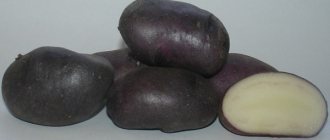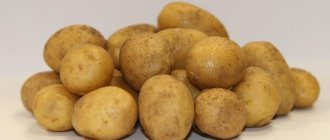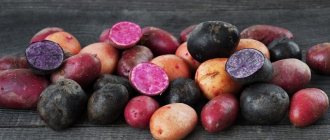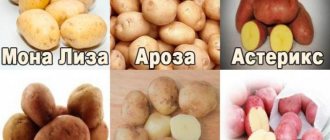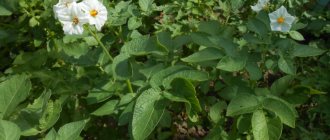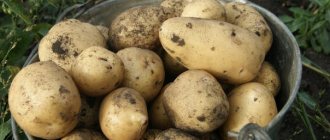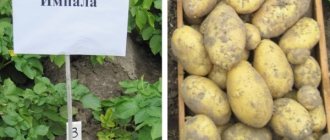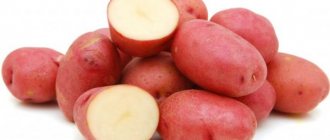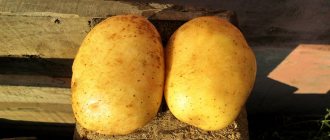Description of the variety
The originator of Azhur potatoes is the Sedek agricultural company. Refers to mid-early table varieties. Recommended for cultivation in the central regions, but is also successfully cultivated in other regions. In the southern regions of the country, the harvest can be obtained twice during the season.
Plant characteristics:
- The potato bush is spreading, vigorous, about 50 cm high.
- The leaves are wrinkled, large in size, and unevenly spaced.
- The inflorescences formed at the tops of the shoots are quite large and light lilac in color.
- The root system is quite developed, 8-15 tubers are formed. Usually they are all leveled, the same in size; these potatoes practically never happen to be small. The surface of the root crops is smooth, the eyes are small and shallow. The potatoes look very attractive, which is clearly visible in the photo.
| Fruit weight/Yield (per acre) | 100-120 g/450-500 kg |
| Tuber shape | Elongated oval |
| Flesh color/Peel color | Light yellow/dark pink |
| Ripening period | Mid-early (75-85 days) |
| Diseases | Resistant to common scab, potato blight, leaf roll virus, and banded mosaic. Can be affected by late blight and golden nematode |
Botanical description
Potatoes are a perennial. Its leaves die off after flowering and tuber formation. Flowers are pollinated by bumblebees and other insects. After flowering, small round green fruits form on the stems. Each of them contains about 300 seeds.
New potato varieties are obtained from seeds. Subsequently, the resulting variety reproduces, like the others, vegetatively, by planting tubers or their fragments. To form a bush, the fragment needs to have 3-4 eyes. Bushes propagated from tubers are clones of the parent plant.
Important! Early varieties are eaten first. Their peel is thinner than the later ones, and this significantly affects the keeping quality of the tubers.
Tubers
The variety is distinguished by medium-sized, uniform tubers weighing from 100 to 120 g. One Azhura bush will provide 10–13 identical potatoes. According to the results of the tests that any variety undergoes before registration in the State Register, the yield was 187–410 c/ha. Azhur showed maximum productivity in the Bryansk region. But mainly it depends on the climate, as well as on the fertility of the soil.
Characteristics of tubers:
- basic: homogeneous, approximately the same weight 100–120 g;
- peel color: pink;
- pulp color: light cream;
- shape: oval;
- eyes: small.
The tubers are characterized by good taste.
The variety is starchy and is intended for preparing various dishes, including French fries and chips. Important! Individuals diagnosed with diabetes need to control their blood sugar levels by consuming potatoes. Its glycemic index
—
95 GI, and this is almost 2 times higher than the norm for diabetics.
Kustov
The Azhur bush is spreading and vigorous, reaching a height of 55 cm. The leaves are large. The edge of the leaf blade is wavy, slightly jagged. Color - dark green. Flowers are purple. There may not be so many of them, but this does not affect the yield.
Advantages and disadvantages
Among the main advantages of Azhur potatoes are excellent yields, which are often even higher than those declared by the originator, as well as early and rapid tuberization. In addition, the variety is valued for its taste and high starch content (14-16%). Suitable for various types of culinary processing.
Other advantages of potatoes include:
- excellent presentation of tuber crops, the possibility of growing for sale;
- excellent keeping quality (up to 95%), if favorable conditions are created at the storage location;
- good tolerance to drought and rare watering;
- general unpretentiousness to the composition of the soil;
- resistance to a number of diseases.
The disadvantages of potatoes include the possibility of damage by golden nematode and late blight. Another downside is that young tubers have delicate and thin skin, which is easily damaged when digging for harvest.
Climatic growing zones
The Azhur potato variety can be successfully grown throughout the Central region of Russia. If you grow the variety in the more southern regions of the country, you are guaranteed to get two full harvests. In the northern regions, the variety can also be grown, but only in heated greenhouses.
In all these areas, the yield can reach 400-500 kg of tubers per hundred square meters.
Keeping quality
When creating this variety, one of the main goals was to obtain planting material that would have an increased shelf life.
This problem was successfully solved and now, with proper preparation for storage (manual sorting, sorting), the grown crop can be stored for 5-6 months without a significant decrease in the original quality.
It is very important that in the room where the grown crop will be stored, the air temperature should be regularly maintained in the area from + 2 to + 4 degrees Celsius. Other requirements for the storage location of potato crops can be found here.
Advantages, disadvantages and taste
Potatoes of the “Azhur” variety have the following advantages:
- High productivity;
- Excellent marketability of root crops;
- Ability for long-term storage;
- Resistant to dry periods;
- Undemanding in frequent watering;
- Unpretentiousness to soil nutrition;
- Immunity to a number of diseases.
The disadvantage of the Azhur variety is its instability to the golden nematode.
The table presents data on the mass of marketable tubers (grams) of different varieties:
| Name | Variety | Weight |
| Nikulinsky | Late ripening | From 70 to 120 |
| Cardinal | Late ripening | 65-110 |
| Rocco | Late ripening | 100-120 |
| Picasso | Late ripening | 80-140 |
| Borovichok | Early ripening | 120-200 |
| Elmundo | Early ripening | 120 |
| Felox | Early ripening | From 100 to 120 |
| Bellarosa | Early ripening | From 120 to 210 |
| Karatop | Extra early | From 58 to 100 |
| Zhukovsky early | Extra early | 100 to 120 |
| Farmer | Extra early | From 90 to 110 |
| Minerva | Extra early | From 120 to 245 |
| Sorcerer | Mid-late | From 75 to 120 |
| Mozart | Mid-late | From 100 to 150 |
| Grenada | Mid-late | From 800 to 100 |
| Melody | Mid-late | From 95 to 180 |
| Giant | Mid-early | 100-140 |
| Tuscany | Mid-early | From 90 to 125 |
| Purple Haze | Mid-early | From 90 to 160 |
| Openwork | Mid-early | 90-120 |
Landing rules
Azhur potatoes can be planted at the end of April or traditionally at the beginning of May. Tubers will not be affected by a short-term drop in temperature. However, it is necessary to wait until the soil warms up to at least 10 degrees Celsius. At this moment, the first leaves of the birch tree bloom. A more reliable criterion is to bury an outdoor thermometer in a 10 cm hole and take readings after 10-15 minutes.
The area for planting Azhur potatoes should be fully illuminated and have a uniform topography (without strong drops and lowlands). The optimal soil type is sandy loam, the environmental reaction is neutral. Before starting work, the field is prepared the day before in the fall, or at least several weeks in advance:
- The area is cleared, the soil is dug up onto the bayonet of a shovel.
- If the soil is not very fertile, apply humus up to 7 kg per 1 m2 or complex mineral fertilizer 30-50 g per 1 m2.
- If the soil is clayey, it is advisable to add sawdust or sand in an amount of 500-800 g per 1 m2.
Tubers begin to be prepared 2 weeks in advance. They are transferred to a bright room and laid out in several layers on the floor or in wooden boxes. Spray periodically and store at a temperature of 14-16 degrees. After 1-2 weeks, shoots will appear on the surface. If individual seeds do not germinate, they are discarded.
On the day of planting, Azhur potatoes are treated with a fungicide (for example, Bordeaux mixture, Fitosporin or Hom), as well as a growth stimulator (Epin, Bioglobin).
The landing algorithm is as follows:
- Several furrows are formed at a distance of 60 cm from each other, oriented from south to north.
- Place the tubers to a depth of 10 cm.
- Leave a distance of 25 cm between adjacent holes.
- Fall asleep and, if possible, mulch with sawdust or straw.
The lighter the soil structure, the greater the depth of planting of Azhur potatoes
Good and bad predecessors of potatoes
When growing this variety, it is very important to take into account the influence of the previous crop. So for potatoes there are both good and bad predecessors. Good predecessors of the variety include peas, soybeans, winter wheat and winter rye.
Bad predecessors are sunflower, tomato, apple tree.
Preparing soil for potatoes
Tilling the soil for planting potatoes begins immediately after harvesting the predecessor. The soil surface is thoroughly weeded to a depth of 2-3 cm.
Using a rake, we rake the remains of tops and weeds from the site and dig up the soil to a depth of 16-18 cm. Under this basic soil treatment, it is advisable to apply basic organic fertilizer in the form of rotted manure. The application rate should be 4-6 kg per 1 m2. In order for the added organic matter to be available to the potato plants, the applied fertilizer must be incorporated into the soil.
In the future, before the planting time, the soil surface must be regularly loosened to a depth of 2-3 cm. Such treatments will allow timely destruction of weeds and high-quality leveling of the surface of the site.
Harvesting
The harvest begins from late June to mid-July. Fully ripened tubers are harvested in August. Signs of full ripening are yellowed bushes with fallen leaves. At the same time, you need to remember that potatoes cannot be kept in the ground. This can lead to bacterial contamination of the tubers.
Harvesting is done with the help of a pitchfork, which is used to dig up the bushes. After this, the potatoes are sorted and only healthy tubers are selected. They are stored in a well-dried cellar or a specially prepared pit. Openwork has the quality of being stored for a long time under appropriate conditions.
Features of cultivation
When growing Azhur potatoes, standard agricultural practices are followed:
- Watering 3 times per season; if there is a drought - every 5 days. It is best to irrigate the bushes in the late evening to prevent burns.
- Feeding - 2-3 times per season: during the formation of buds, during and after flowering. You can add mullein or herbal infusion. At the same time, Azhur potatoes are especially responsive to potassium salt, which is given in combination with superphosphate (1:2).
- Hilling up - the first time after the bushes grow to 12 cm, then every 3 weeks (if necessary).
- Weeding - regularly.
- Loosening the soil is frequent, especially after watering and heavy rains.
Watering and loosening
To moisten the surface of the beds, choose morning or evening time. Fluid consumption depends on the stage. Before flowering, the moisture norm per 1 m2 is 25-30 l, during the budding phase - 30-40 l, when tubers gain weight - 45-50 l.
The frequency of watering is 1 time every 10-14 days. If the summer is not hot, with precipitation, 3 humidifications per season are enough.
Hilling
The procedure is combined with loosening. During the growing season, 2-4 hillings are performed at intervals of 1 time every 20-25 days. For carrying out, choose a cloudy day so that the soil is not overdried.
What are the conditions for hilling:
- the first procedure with a stem length of 8-10 cm;
- the second time at a height of 16-18 cm;
- the third time when the shoots are 25 cm long.
Top dressing
7-10 days after germination, solutions of mullein or manure are added (dilution 1 to 12 or 1 to 15). It should be left for 2-3 days.
On the eve of flowering, water with a phosphorus-potassium mixture. Add 1 tbsp to 10 liters. l. superphosphate and potassium sulfate, as well as 3 tbsp. l. ash powder. For leaf irrigation, urea is used (diluted 300 g per 10 l).
During the active flowering phase, Oma, Bulba, and Kemira are used. Spray with superphosphate and potassium salt (10 liters of solution per 10 m).
Care
Varietal potatoes Azhur do not require any special care. It will be enough to do timely watering, loosening and hilling. It is also necessary to remove weeds from the area where this vegetable grows.
Watering
Regardless of the fact that Azhur easily tolerates drought, timely watering will only benefit the future harvest. This procedure should be carried out once every two weeks, in the evening or early morning. In this case, water consumption should be at the rate of 50 liters of water per square meter. If enough rain falls during the season, then watering may not be necessary.
Reviews about the variety
Alexey, 43 years old, Ryazan Planted 10 Azhur potato tubers on his plot. I am delighted. At the beginning of August I harvested, each bush yielded 20 root crops weighing from 160 to 200 grams. The peel is pink, the flesh is yellow, the taste is excellent. According to my calculations, about 80-100 tons of crop can be harvested from one hectare. Marina, 30 years old, Ivanovo Last year she planted Azhur. I bought 10 tubers the size of a walnut. The harvest was very good; in total, about 4 buckets of large potatoes were harvested. It contains a large percentage of starch. It gets soft when cooked. My children say that these potatoes are for the lazy, as the mashed potatoes are prepared immediately. The variety loves loose soil and various fertilizing.
Description of culture and characteristics
“Azhur” belongs to the mid-early table variety and is quite productive. After the seedlings form and until the vegetable ripens, it usually takes from seventy-five to eighty-five days. The digging process should be carried out about twenty days earlier.
The bush of this plant is characterized by spreading and vigorous growth, the average height is about 50 centimeters. The leaves are evenly spaced, large in size and dark green in color, as well as a wrinkled structure and wavy edges. The top is the place for the arrangement of inflorescences, which have large light lilac flowers.
Potatoes have medium-sized, oval-shaped tubers that are usually uniform. The characteristics of the peel include sufficient density and dark pink color. The tubers are smooth to the touch with small and shallow eyes. The straw-colored pulp contains a lot of carotene. This fruit is very tasty and has a bright aroma. Each of the "Azhura" bushes produces a harvest of up to fifteen root crops, which have the same average size. Typically, one hectare yields approximately fifty tons of crop.
"Azhur" is a potato with a high starch content. This is why it is often used to prepare delicious dishes and can be fried, boiled and stewed.
Reviews about the Azhur potato variety
Anton, Borisoglebsk
The variety is quite productive with excellent taste. Rarely gets sick. It is stored for a long time in winter. The tubers are large and have a beautiful appearance.
Anna, Nizhny Tagil
I have been growing this variety for more than five years. All these years we have been able to obtain decent harvests. Plants develop quickly and produce large tubers. The main thing is to water it on time and fight the Colorado potato beetle in a timely manner.
Sergey, Naberezhnye Chelny
I experimented with different varieties for many years but settled on this one. After all, only this variety is capable of producing significant yields with relatively simple growing technology. The taste is excellent and the harvested crop can be stored for a long period of time.
The best potato varieties: top 36 by yield and taste
Remember! You can get a rich harvest of tasty potatoes only if 3 main points are observed: 1. High-quality planting material suitable for the given region and climate has been purchased. 2. You have fertile land, you follow the rules of crop rotation. 3. You use the correct agricultural technology for growing potatoes.
If you do not comply with at least one of the points, then there can be no talk of any high yields and tasty tubers.
Next, we will consider in detail the most popular potato varieties (in alphabetical order), which are popularly recognized due to their high yields or due to their excellent taste, although most often they combine both main characteristics.
Aurora
Mid-season variety, table purpose, high-yielding, excellent taste.
The variety is able to adapt to any climatic growing conditions, and is also quite undemanding regarding the type of soil.
Resistant to potato blight and nematodes, moderately resistant to viruses, moderately susceptible on tops and tubers to the causative agent of late blight,
The taste is excellent. When ready, the potatoes become crumbly (medium boilability). Culinary type VS. Suitable for making soups and purees.
Characteristics of the Aurora variety:
- ripening period - mid-season (90-110 days);
- the shape of the tubers is oval (leveled);
- peel structure - smooth;
- peel color - yellow;
- pulp color - white (cream);
- the depth of the eyes is shallow;
- starch content - 13.5-17.3%;
- yield per hundred square meters - 214-396 kg (maximum up to 416 kg);
- number of tubers per bush - from 20-25;
- the average weight of 1 tuber is 93-128 g;
- marketability - 80-93%;
- keeping quality - 94%.
In appearance it is distinguished by tall bushes with large foliage of a light green hue. The inflorescences have a red-violet hue. Berry production is average.
Regions recommended for planting: Northern, Northwestern, Central, Volga-Vyatka, Central Black Sea Region, North Caucasus, Middle Volga, East Siberian, Far Eastern.
Patent holder or originator of the variety: Vsevolozhskaya Breeding Station LLC (Russia).
Adretta
One of the most common old varieties.
Mid-early, table purpose, high-yielding, excellent taste.
The variety is distinguished by its stable annual harvest, very rapid initial development, powerful growth of tops and early tuberization.
It gives good results when grown on different types of soil, but it is not suitable for areas that are too dry or that change their humidity frequently.
Adretta has increased resistance to common crop diseases, and also tolerates adverse weather conditions (resistant to short-term frosts). Therefore, tubers can be planted at the end of April or beginning of May, without fear of return spring frosts.
Important! Increased soil moisture and stagnant moisture have a negative impact on tubers. Ripe fruits begin to rot in damp soil.
Resistant to cancer, relatively resistant to viruses, but susceptible to late blight, common scab, and rhizoctonia.
The taste of the variety is simply excellent, so its use in many dishes is acceptable. Potatoes soften very well during cooking. Culinary type C. Suitable for cooking. It’s just the perfect variety for purees; you don’t even need to add oil.
Note! Adretta (as well as almost all potato varieties) needs regular renewal of planting material every 3-5 years.
Characteristics of the Adretta variety:
- ripening period - 80-90 days (mid-early), according to other sources - 70-80 days (early);
- the shape of the tubers is from round-oval to oval;
- peel structure - mesh;
- peel color - yellow;
- pulp color - light yellow;
- the depth of the eyes is shallow;
- starch content - 13-18%;
- yield per hundred square meters - 200-450 kg per hundred square meters (according to other sources - 214-396 kg);
- the number of tubers in a bush is 15-25 pieces (from medium to high).
- the average weight of 1 tuber is 100-150 g;
- marketability - high;
- keeping quality - 98%.
The appearance of the plant is erect, tall, has large light green leaves, and the flowers are white.
Recommended regions for planting: Middle Volga, West Siberian and Far Eastern.
Patent holder or originator of the variety: Norika Nordring Kartoffelzucht und Vermehrungs GmbH (Germany).
Bellarosa (Bella Rosa or White Rose)
Early ripening variety, suitable for table use, good yield and taste.
Interesting! Due to the specific bright red color of the peel, in Russian-speaking countries it received the popular name - Cherry potato .
The variety is not demanding on humidity and tolerates hot periods without loss of fruit quality. Any soil type is suitable except heavy loamy soil.
Advice! It is advisable to germinate before planting. Responds positively to fertilization.
In most cases, it manages to bloom by the time mass quantities of the Colorado potato beetle appear. The variety is also resistant to the potato cancer pathogen and nematode. Tolerates transportation well.
The taste is good. During cooking, the pulp becomes crumbly.
Young potatoes can be dug up already on the 45th day after germination.
Characteristics of the Bellarosa variety:
- ripening period - early (70-80 days);
- the shape of the tubers is oval-round;
- peel structure - rough;
- peel color - red;
- pulp color - light yellow;
- eye depth - shallow or medium;
- starch content - 12.6-15.7%
- yield per hundred square meters - 169-326 kg (maximum up to 385 kg);
- number of tubers per bush - 8-9;
- the average weight of 1 tuber is 117-207 g;
- marketability - 82-99%;
- keeping quality - 93%.
Appearance of the plant - forms tall, erect shoots with large green leaves. The inflorescences are medium-sized and have a red-violet hue.
Regions recommended for planting: Northwestern, Volga-Vyatka, Central Black Sea Region, Ural.
Patent holder and/or originator of the variety: Europlant Pflanzenzucht GmbH (Germany).
Rosara
The leader among early ripening varieties is the result of German selection, which is ideal for growing in the middle zone. Its yield does not depend on weather conditions. Every year, up to 18-20 selected tubers are harvested from one plant, and 500 kg or more from 1 hundred square meters. Bushiness is semi-spreading, medium. The tubers are oval and regular in shape. The peculiarity of the variety is that all root crops are the same size, as if they had been calibrated. The eyes are shallow and poorly expressed. The peel is thin, pink-red to coral in color. The pulp is yellow.
"Rosara" is one of the few varieties that shows resistance to all types of diseases. In addition, it is not afraid of either dry weather or prolonged waterlogging. Soil for planting can be of any type. Keeping quality is high, without rotting. Marketability is 99%.
According to reviews, the taste is excellent. Potatoes are used for boiling, frying and in salads. The variety does not require frequent renewal of planting material. Productivity remains stable for up to 5 years.
Luck
Third place in the ranking is occupied by a variety bred by Russian breeders. It is characterized by high yield even in unfavorable growing seasons. From 1 acre, up to 500 kg of tubers with light sandy thin skin and snow-white pulp are collected. Up to 20 pieces ripen on 1 bush, the average weight of which ranges from 150 to 200 g. “Luck” is widespread not only in the middle zone, but also in the Far East.
The variety is highly resistant to pests and diseases: late blight, wet and dry rot, scab, blackleg, rhizoctonia, mosaic viruses. It tolerates any vagaries of weather, including drought and prolonged downpours. As summer residents note, the crop is stored for a long time, is resistant to mechanical stress, and does not rot. Potatoes have a delicate taste, do not overcook, and are used for all types of dishes.
The bushiness of the variety is medium, spreading. Starch content – 12%. It is recommended to start planting when the soil is well warmed up.
Nevsky
In second place in the ranking is the result of domestic breeding, which is considered one of the most popular varieties among summer residents and farmers. It was launched in 1976 and is still not inferior to many new products in its high characteristics. According to statistics, about 26% of agricultural areas allocated for potatoes are allocated to this variety. The yield per 1 hectare reaches 600 kg. Up to 15 tubers weighing 100-130 g are collected from one bush. They are smooth, oval with a smooth thin skin. The pulp is snow-white. The eyes are red, few in number, and not deepened.
The variety is universal and recommended for planting in all regions of the country. It has a high immunity to disease, responds normally to unfavorable weather changes, and is suitable for seedlings in all types of soil. The culture is drought-resistant due to its powerful root system. It normally tolerates mechanical stress during cleaning and is not susceptible to bacterial and fungal diseases. During particularly hot periods, the leaves are curled into tubes to reduce moisture evaporation.
The taste of potatoes is very delicate. It does not boil over, holds its shape, and is easy to clean and wash. Low starch content means that peeled root vegetables do not darken for a long time. Marketability – 95%. The tubers are stored until spring.
Lorch
A worthy leader in our rating is a table variety bred by the famous Soviet breeder A.G. Lorch in 1922. It is known to every vegetable grower in our country and is loved by many summer residents and farmers because of its environmental plasticity, high taste and preservation qualities, immunity from diseases, viruses and pests. The bushes are tall and erect. The tubers are oval, elongated, weighing 100-115 g. 9-11 pieces are formed in one nest. From one hundred square meters they consistently harvest 300-350 kg. In a favorable season - 400 kg. The peel is smooth, the flesh is white.
The variety is universal, recommended for all types of culinary processing. It is used industrially to make starch. The tubers are easily peeled and do not darken when cut. Keeping quality is high. Potatoes are not susceptible to mechanical stress and are stored until summer. It is not picky about soils and does not require special care.
Thanks to their age, potatoes have taken root not only in the middle zone. It is grown in various climatic zones of our country. It is also popular among European farmers.
Diseases and pests
The Azhur variety is resistant to potato cancer and scab. But it can be affected by golden nematode and late blight.
The photo shows a potato affected by the golden nematode.
Let's look at the most common diseases of Azhur potatoes in the table:
The bushes turn yellow and lag behind in development. The foliage dries and curls. Many adventitious roots are formed. The tubers are small.
The infected plant is dug up along with a lump of earth and destroyed. Planting potatoes is alternated with rye, beans, marigolds and calendula. In case of severe damage, chemicals are used - thionazine.
The appearance of brown spots on leaves and stems. At high humidity, a white coating forms. Depressed spots are found on Azhur potato tubers.
Chemical preparations used include Quadris, Ridomil Gold or Bordeaux mixture. From biological ones - Trichodermin or Fitosporin. The plant is sprayed according to the instructions.
Dry, brown spots appear on leaves and stems. The tubers are covered with large depressed spots.
Before planting, the tubers are sprayed with Integral or Bactofide. During the growing season, the following drugs are used: Profit, Abiga-Pik, Thanos, Novozri and Metamil.
Among the pests, Azhur potato bushes are usually affected by Colorado potato beetles, wireworms, mole crickets and moths. The most effective drugs against them are Aktara, Prestige, Corado and Regent.
Potatoes for clay soils
Clay soil is not considered the most favorable for growing potatoes. It is viscous, dense, impermeable to water. That is why plants are deprived of the opportunity to absorb beneficial substances contained in the soil. The composition of clay soil must be improved by adding sand, sawdust or ash. You should not allow the formation of a hard crust on the surface. It appears after watering or rain. The problem is solved by loosening.
In such difficult conditions, potatoes are grown in ridges or in high beds. The planting should be shallow. To increase the yield, compost or peat is added during autumn plowing to a depth of at least 30 cm. The varieties Gatchinsky, Golubizna, Istrinsky, Zarevo, Rozara, and Lugovskoy show good results on clay soil.
One of the most unpretentious and drought-tolerant varieties is the Cleopatra variety. Its fruits are large and recover well from mechanical damage.
The most persistent
Most often, potatoes suffer from the Colorado potato beetle, late blight and golden nematode. They are capable of individually destroying up to half of the entire crop. Today, the only way for a gardener to provide protection from pests is to grow resistant varieties. For example, late blight develops in regions with high humidity. If there are frequent heavy rains, fog and dew form, then you need to choose species with good resistance to all these factors - species such as Borodyansky pink, Chervona rue, Bellarosa, Arosa, Zhivitsa.
Thick-skinned fruits are resistant to pests. To protect against the larvae of harmful insects, the varieties Bellarosa, Chervona Ruta, Sante, Vineta, Bagryany are planted. The possibility of scab infection is high on alkaline soils, such as chernozems, sandstones, and solonetzes. To combat the disease, it is unacceptable to use unrotted manure or liming. This will lead to an increased alkaline reaction. As an alternative, you can add gypsum, pine needles or sulfur during autumn plowing. This will help acidify the soil. Such types of potatoes as Grouse, Crimson, Fantasia, Agave, Karatop, Bellarosa, Arosa are resistant to scab. The Picasso variety is considered the most resistant species.
If the plants are unnaturally short, this indicates the presence of golden nematode in the area. The varieties Vineta, Arosa, Laura, Sante, Finka resist it well.
For long-term storage
Vegetables of mid-season and late-season varieties are preserved for a long time. They have a thick peel and a high composition of microelements.
Among the best varieties of potatoes for winter storage, we can recommend the following types:
- Lorch. Medium late. Snow-white peel, white interior. Weight from 95 to 120 g.
- Bryansk is reliable. A mid-late variety vegetable. Vegetation period – 96-115 days. Weight 85-125 g. Surface – red, inside – white.
- Stonefly. Late ripening. Oval-round tubers. Ripens: 115-125 days. The rind is yellow, the flesh is creamy.
- Atlant. Late. Vegetation occurs within 115-125 days. Weight 95-125 g. The surface is yellow, the inside is light yellow.
- Asterix. Late. Ripens in 100-110 days. Tuber weight 85-115 g. The rind is pinkish-violet. The interior is bright yellow.
- Crane. Medium late. The growing season is 110-125 days. Weight from 95 to 160 g.
- Loshitsky. Medium late. The surface is white, the inside is light yellow. Weight 95-110 g.
Salad
Salad root vegetables contain little starch. Delicious in any form. The salad and vinaigrette are prepared from varieties that have red, blue and purple flesh. The brighter the color of the potato, the greater the amount of useful elements it contains.
Popular varieties of this potato:
- Red Scarlet. Preserves and tolerates short-term drought. The rind is red, the inside is yellow. The growing season lasts up to 80 days. Weight up to 125 grams.
- French truffle. It has an original purple color both outside and inside. Suitable for making salads and vinaigrettes, does not boil over. You need to clean it after it cools down. The fruits are small, weighing up to 75 grams. Late variety. It is grown by hand in small beds. Potato seeds are expensive.
Productive
All gardeners are interested in productive varieties of potatoes. With uncertain farming and capricious weather, it is not desirable that regular cultivation of the soil, control of weeds and pests results in a small harvest: less than what was planted. Therefore, choosing potato varieties is a major task that requires serious study of growing methods.
These varieties include:
- Idaho. Early ripening. They are resistant to diseases.
- Bela Rosa. The tuber is oblong in shape. The weight of the vegetable is two hundred to five hundred grams.
- Picasso. Late ripening. Ripens in 115-130 days. The outside color is pink-yellow. Weight from 110 to 145 grams. The pulp is white-yellow in color. The taste is pleasant. To be stored.
- Gala. Imported from Germany. Delicious. The rind and interior are yellow. The weight of the root crop is 70-135 g. It ripens in 80 days.
The best varieties by ripening time
Depending on the ripening period, the following potato varieties are distinguished:
- early ripening (the harvest is obtained in 70-80 days);
- mid-early (potatoes are ready for harvesting in 80-90 days);
- mid-ripening (ripening lasts 90-100 days);
- medium-late (potato harvest is harvested in 100-120 days);
- late-ripening varieties (potatoes are harvested after 120-140 days).
The best varieties of early ripening species include the following:
- Early Bryansk. The ripening period is 60-70 days. Potatoes of this variety have a good taste. It is suitable for baking, frying, salads. Percentage of keeping quality – 93%. Early Bryansk tolerates hot weather well and is immune to many diseases.
- Uladar. The ripening of potatoes of this variety takes only 45 days. The tubers are unpretentious to the type of soil and can be stored for a long time.
- Ariel. Potatoes of this variety ripen even before there is a threat of late blight infection. Tuber ripening lasts 45-50 days. Thanks to such record-breaking deadlines, 2-3 harvests can be harvested during the summer-autumn period.
- Red Sonya. This variety ripens in 50-65 days. It can be grown in any soil and in any climate. The Red Sonya variety is resistant to viruses and nematodes, and exhibits average resistance to late blight and common scab.
- Jewel. The ripening period is 50-65 days. It tolerates drought well and can produce two harvests per season. Jewell adapts to any soil and climate and is resistant to cancer and potato nematode. It has a mediocre taste, suitable for boiling and frying.
- Gulliver. Ripening time is up to 60-70 days. It is immune to most common diseases and has good taste. Potatoes of the Gulliver variety keep well.
Well-known mid-season potato varieties include:
- Queen Anne. Ripening period is 80-85 days. This is a mid-early variety that produces a good harvest - up to 457 centners per hectare. Queen Anna potatoes have a good taste and are characterized by a high shelf life. During transportation, the tubers do not deteriorate and do not lose their presentation.
- Romano. This variety produces a harvest of delicious root vegetables that are suitable for preparing any dishes. The ripening period is 65-80 days. The vegetable has a good taste, is well stored and transported thanks to its thick peel.
- Laura. This is a mid-early red potato variety. Ripening period is 70-80 days. Yields up to 510 centners per hectare. Laura variety potatoes have a pleasant taste and are suitable for boiling, frying, making salads, as well as French fries and chips.
- Openwork. Potatoes of this variety are mid-early. The tubers are beautiful, oval. The ripening period is 70-85 days, although the first digging is possible already on the 45th day.
Late types of potatoes that are especially popular are:
- Melody. A mid-late variety that is suitable for preparing any dishes. The ripening period is 115-120 days. The variety is resistant to most diseases that affect this crop. Melody potatoes keep well.
- Ivan da Marya. Can be grown in different climate zones. The ripening period is from 120 to 150 days. It has a good taste and is suitable for preparing any dishes. During the dry season, potatoes of this variety definitely require watering, otherwise the bush dries out.
- Picasso. The variety is resistant to elevated temperatures and drought. Ripening time is 110-130 days. In addition to excellent taste, potatoes of this type are characterized by good yield: you can get from 200 to 500 centners of potatoes per hectare. Keeping quality is 90%.
- Manifesto. It is a mid-late vegetable variety. After ripening, a lot of tubers are obtained; the potatoes store well and are suitable for preparing any dishes. Productivity per hectare is up to 737 centners. The ripening period is 90-110 days. The Manifesto variety is highly resistant to viral diseases, moderately resistant to common scab and late blight.
A wide selection of potato varieties will allow you to choose the optimal one to obtain a good harvest within the required period.
Characteristics
It is considered a high-yielding variety. Under favorable conditions and proper care, it is possible to collect up to 50 tons from 1 hectare. During the first harvest when the potatoes are about 40 days old, you can collect about 130 quintals per hectare . There are practically no small tubers, the potatoes are uniform in size.
Productivity is one of the main indicators when growing potatoes. Compare this characteristic of the Azhur variety with other varieties:
| Variety name | Productivity |
| Openwork | 450-500 c/ha |
| Grenada | 600 c/ha |
| Innovator | 320-330 c/ha |
| Melody | 180-640 c/ha |
| Mistress | 180-380 c/ha |
| Artemis | 230-350 c/ha |
| Ariel | 220-490 c/ha |
| Vector | 670 c/ha |
| Mozart | 200-330 c/ha |
| Borovichok | 200-250 c/ha |
"Azhur" is a table variety. Due to the average starch content, the tubers do not become overcooked; they are ideal for making soups, salads, whole cooking, and frying. “Azhur” does not darken after cooking.
Attention! Potato skin contains more beneficial microelements than the tuber itself. The most useful cooking method is boiling or baking in the peel.
Potatoes contain a lot of useful substances, most of all vitamin C. Raw potato juice will help lower blood pressure. It is used in cosmetology as a mask for swelling and for skin whitening. “Azhur” has a rich taste and pronounced aroma. Reviews about the taste of potatoes are only positive.
Read all about the properties of potatoes on our website. Why is solanine dangerous, what are the benefits and harms of raw potatoes, what are the health benefits of the juice and sprouts of this vegetable.
Newest varieties
In recent years, it has been possible to develop many new potato varieties. Breeders pay maximum attention to such parameters as disease resistance and yield.
Rowanushka
The variety is considered productive, since up to 400 kg can be harvested from one hundred square meters. Intended for cultivation in open ground. Undemanding to soil. The fruits are smooth and oval, red in color, weighing from 90 to 135 g.
The starch content is high. Not resistant to diseases and pests. Despite this, in Russia this variety is considered in demand.
Sarovsky
Precocious appearance. Productivity ranges from 340 to 460 kg per hundred square meters. It is undemanding to both climate and soil. Tolerates high humidity well. The tubers have an excellent taste and a round shape.
Possible colors are red and cream. Potatoes can reach a weight of up to 580 g.
Scarlet Sail
The starch content in such potatoes is up to 25%. Shows resistance to scab, late blight, nematode. The tubers are pink, oval in shape.
In the category of the newest varieties there are also Dutch ones, such as Eba, Estima, Prior. They are already recognized as one of the highest quality and most productive.
Sources
- https://fermilon.ru/sad-i-ogorod/ovoshhi/kartofel-azhur.html
- https://sad24.ru/ogorod/sort-kartofelya-azhur.html
- https://VesOgorod.ru/harakteristika-sorta-kartofelya-azhur/
- https://2rediski.ru/kartofel/azhur/
- https://repka.online/ovoshhi/kartofel/sredneraniy/azhur.html
- https://countryhouse.pro/samye-urozhajnye-sorta-kartofelya/
- https://expertology.ru/12-luchshikh-sortov-kartofelya-dlya-sredney-polosy/
- https://zen.yandex.ru/media/id/5cb834dfe600aa00b5d7225c/5cd05080d31aa100b34536cf
- https://udobryashkin.ru/ovoshhi/luchshie-sorta-kartofelja
- https://ferma.expert/rasteniya/ovoshchi/kartofel/luchshie-sorta-kartofelya-dlya-posadki/
[collapse]
